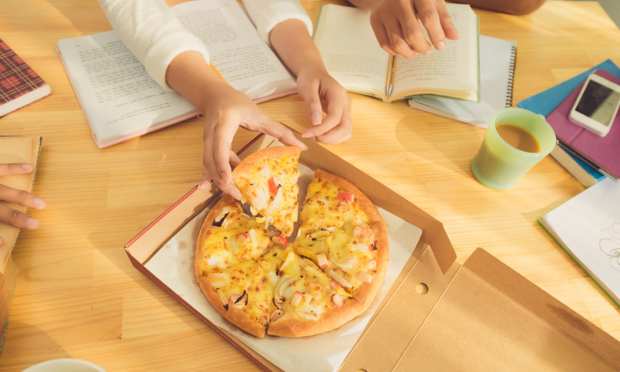Campus Ghost Kitchens Cater To Students’ Changing Dining Habits

The past year has seen a massive shift in habits across demographics. For many consumers, this meant tending toward grocery stores where previously they would have dined out or switching to off-premise ordering instead of eating in restaurants. On campuses across America, students had to adapt to their own unique set of circumstances. After all, the typical buffet-service model of university dining halls hardly lends itself to COVID-safe practices.
This posed a unique opportunity for campus food service company Chartwells Higher Education to transform the campus dining model. Taking its cue from the wider restaurant industry, the company created a ghost kitchen program to offer the flexibility to meet students’ ever-changing needs. These delivery-only outlets, visible to students as online menus, offer a safe, remote alternative to more traditional campus dining options.
“We have found that the success of our ghost kitchen program is directly tied to its flexibility,” Chartwells CEO Lisa McEuen told PYMNTS in an interview. “Many of our campuses are already well-equipped to implement ghost kitchens at a low cost without having to replace any meal concepts or shut down a location … the most successful ghost kitchens are ones that can flex their menus and offerings quickly to adjust to student feedback and needs.”
These ghost kitchens are a supplement to, not a replacement for, core campus meal options. Shortly after campuses closed last spring, Chartwells announced its Path to Open, suggesting safe dining solutions going forward. “By April, we had created tools and sent our partners a catalog of solutions,” said McEuen, adding that the company presented these solutions to universities via bi-weekly webinars. After the Path to Open, there was this past fall’s Path Forward, which includes the ghost kitchens and the company’s contact-free catering program, stressing flexibility as needs change campus-to-campus.
The program is rolling out nationwide after a successful pilot at a handful of universities, starting with Seattle University last September. In addition to students’ appreciation of the wider range of menu options afforded by these kitchens, parents have also been vocal in their praise of the program, which can be key, given that many parents bankroll their children’s campus dining. “They have shared feedback … stating that the new options are exactly what their students were looking for,” said McEuen, adding that they “appreciate that our team built this program based on their direct feedback.”
As our understanding of the virus has evolved, and as cases spike and subside across regions, demands have been extraordinarily difficult to predict. As McEuen explained: “Over the last year, our client partners needed us to provide unlimited flexibility, from last-minute feeding of thousands of quarantined students to completely new service models as an answer to evolving CDC guidance and campus populations.”
The adaptability of the ghost kitchen model is especially valuable right now, as dining behaviors change not only in response to the logistical needs of anti-viral regulations that vary week-to-week and location-to-location but also in response to the emotional circumstances of the pandemic. In PYMNTS’ How We Eat report in June, researchers found that consumers’ diets are polarizing, with more nutritious choices and more familiar foods increasing in popularity: 39 percent of those surveyed eat healthier foods and 40 percent reported eating more “indulgent” fare.
Restaurant industry giants have found that comfort foods have been in high demand and that people crave indulgences at odd hours. The same is true for students on campuses. As McEuen put it, “because student needs and habits are changing, the best ghost kitchens are ones that can offer extended hours and late-night options adding additional value to their meal plans and on-campus dining.”
Looking ahead to the near future of campus dining, McEuen predicted, students’ needs will not normalize to preferring any one channel over others, but rather students will come to expect a wider range of options. “According to the survey that we conducted with our campus partners, we are seeing that nearly 70 percent are looking for ways to continue to offer takeaway in resident dining as well as reopen resident dining halls, and over 50 percent are interested in mobile ordering and pickup retail that eliminates checkouts and want options for on-campus delivery,” the announcement noted.
